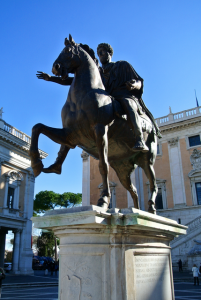
Marcus Aurelius in the Campidoglio
Rome truly is the eternal city. It is home to roughly three million and the host to nearly nine million tourists each year.
Central Rome is one of the world’s greatest walking cities with unimaginable wonders lying around each corner. Ancient buildings and ruins stand next to masterpieces from the Renaissance and Baroque periods that are all enveloped in modern dwellings and businesses.
The famous sites of Rome should be on everyone’s bucket list. A handful of Rome’s great sites will require a paid ticket for entry but there are dozens of attractions that requite nothing more than a map to locate.
The Colosseum (including the Roman Forum) and The Vatican are among the most popular of Rome’s sites and both will require an entry fee. I strongly recommend a visit to both. Unless you desire the experience of knowing how a steer must feel on the big round-up, I suggest you book a tour in advance of your trip. The incredible draw of these sites results in massive queues.
I recommend that you book a VIP tour to both that allows you to skip the lines, see restricted areas, and have the benefit of a professional tour guide. There are several good tour companies in Rome but recently I booked with The Roman Guy and had the best tour experience ever in Rome.
The first Roman tip that rules over all others is to take Rome slow. In Rome there is something to see on every street and every corner. It is highly unlikely that you will check all of the boxes on your Rome to-do-list. That’s okay – it’s just another reason to make a return trip.
Below is a partial list (there are many more amazing things to see) of my favorite sites in Rome that require no booking and no entry fee.
Piazza Navona
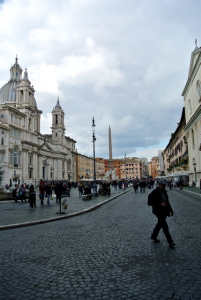
Piazza Navona Rome
On the site of the 1st century Stadium of Domitian (aka Circus Agonalis) built in 86 AD by the Emperor Domitian. The stadium was a classic Greek model seating 20-30k people. Public executions were also held at the stadium with the most notable being that of Saint Agnes who was martyred at the spot that now occupies the 17th century Sant’Agnese in Agone – a church dedicated in her honor.
The Piazza Navona became public square in 15th century when Rome’s city market moved from the Campidoglio (Capitoline Hill). The square changed again significantly in 17th century with Baroque influence during the reign of Pope Innocent X. This Pope was a member of the influential Pamphili family who in the 16th and 17th centuries contributed several Popes and Cardinals. The family palace, Palazzo Pamphili (architect Rainaldi), is on the piazza.
Innocent X commissioned the Fontana dei Quattro Fiumi at the square’s center created by Gian Lorenzo Bernini (1651). The fountain consists of the four river gods of the four major rivers on continents then dominated by papal authority: Nile (Africa), Danube (Europe), Ganges (Asia), and Rio de la Plata (Americas). The fountain is topped with an obelisk first commissioned by Emperor Domitian and erected at the Temple of Serapis & Isis (it was later moved to Circus Maxentius).
On the square to the south of the Fontana dei Quattro Fiumi is the Fontana del Moro that was created by Giacomo della Porta in 1575. In 1653 Bernini added the “Moro” and dolphin statue at the fountain’s center. Della Porta was also responsible for the Fountain of Neptune base — the Neptune sculpture was not added until the 19th century to give the piazza better symmetry.
If you would like to see how the piazza looked in the time of Domitian you can visit the Stadio Domiziano Museum (open daily 10-7 – 8 euros) at the North exterior of the Piazza Navona. There are several intact archways that supported the stadium’s stands that can be viewed at the original street level now located several meters below the current street.
Pantheon & Piazza della Rotonda
Built on the site of a temple (or Pantheon) built by Marcus Agrippa (right hand of the first Emperor Augustus) near 27 BC. This original Pantheon burned down in 80 AD and was rebuilt then by the Emperor Domitian near 83 AD. Domitian’s Pantheon was struck by lightning in 110 AD and it too burned to the ground.
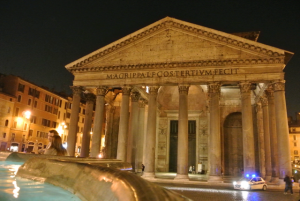
The Pantheon Rome
In 118-126 Hardrian began the building of the ultimate Pantheon that stands today. He was likely deeply involved in the design but the architects are unknown. The Pantheon is the most intact structure from imperial Rome. This remains one of the most important buildings ever constructed and its design has been copied the world over.
You enter the Pantheon through the portico that features massive granite columns 40 feet tall and each weighing in at 50 tons. They were each quarried from a single piece of stone in Egypt and then transported across the Mediterranean and then up the Tiber River.
Once through the portico and the colossal doors you enter the rotunda. This is the true engineering and construction achievement as the room is perfectly symmetrical being able to perfectly fit a 43.3 meter sphere. The walls of the drum are 20 feet thick to support the weight of the concrete dome above. This is still the largest, unsupported concrete dome in the world having been cleverly created by using heavy concrete at the dome’s lower rings and progressively lighter mixes of concrete as it rises. The thickness also tapers starting at 21 feet at the base and narrowing to just under 4 feet at the highest point surrounding the oculus. The oculus is open to the elements as it was in the beginning by design offering natural light and structural integrity.
The floors feature marble gathered from various points in the empire and these are as they were when the Pantheon’s builder Hadrian walked these floors nearly 2,000 years ago.
The square in front of the Pantheon has changed much since its construction. The Piazza della Rotonda took shape in the 16th century with a fountain basin built by Giacomo della Porta for Pope Gregory XIII in 1575. The obelisk was added by Barigioni under Pope Clement XI in 1711. The obelisk (more than 1000 years older than the Pantheon) was brought to Rome by the Emperor Augustus and was originally built by Rameses II at the Temple of Ra in Heliopolis.
Campo de’ Fiori

Campo de’ Fiori Market
In ancient Rome the area that is now Campo de’ Fiori was unused meadow near Pompey’s Theater. This area was prone to floods from the nearby Tiber River and not until the Tiber was tamed with flood control measures did this evolve into one of the city’s main squares.
A market did arise here in the Renaissance period and it also had a more sinister use as a spot for public executions. Perhaps the most infamous execution was that of Giordano Bruno in 1600 – his statue now looms central in the market square. Bruno openly shared his theory that stars were actually distant suns with their own exoplanets and perhaps some of these planets could support life. He stated that the universe was infinite and that there could therefore be no “center.” In 16th century Rome that sort of talk would get you jailed by the church and in Bruno’s case, burned at the stake.
Today Campo de’ Fiori is the site of the city’s primary, daily market (since 1869) in the day and a vibrant center for dining and drinking in the evening hours. (Do not eat at any of the restaurants on the square!)
Piazza di Pietra – Temple of Hadrian
This temple is far more of a ruin than a temple but as it lies just 300 meters from the Pantheon and is very near other notable landmarks, it’s worth a look. It was built by Hadrian’s adopted son and successor Antonius Pius in 145 AD. Visible now are 11 of the original 15 columns from the northern face of the temple. For many years this ruin was misidentified as the Temple of Neptune. The columns are located on the charming Piazza Pietra. Unlike many other squares in this part of Rome Piazza Pietra is home to restaurants and bars well worth visiting.
Piazza Colonna – Column of Marcus Aurelius
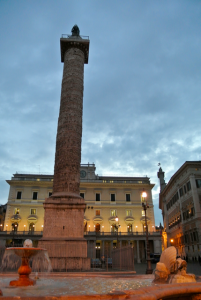
Column of Marcus Aurelius
The Column of Marcus Aurelius was built by his son Commodus in 193 AD. The column consists of 28 blocks of Carrara marble each 3.7 meters diameter with a hollow center. It was modeled after Trajan’s column that stands in Trajan’s Forum. Originally the column featured a statue of Marcus Aurelius at the top but this was replaced with a figure of St. Paul placed by Pope Sixtus V in 1589.
While many of ancient Rome’s monuments have been relocated (due in part to them being buried and/or lost) the Column of Marcus Aurelius stands in its original spot although the column’s base has been replaced. The Piazza Colona is located along Via del Corso between Piazza Venezia and Piazza del Popolo steps away from both Piazza di Pietra and the Palazzo Montecitorio.
Obelisk of Montecitorio
Also known as Solare, the Obelisk of Montecitorio was first purposed in Rome as centerpiece of a giant sundial (the Solarium Augusti) located very near its current location on the Piazza di Montecitorio. This obelisk was taken from Egypt in 10 BC by the Emperor Augustus along with its companion obelisk, Flamino, that now resides in Piazza del Popolo. The red granite obelisk was originally built by Psammetichus II in Egypt near 590 BC.
Trevi Fountain
The Trevi Fountain (Fontana di Trevi) is the largest Baroque fountain in Rome. The location is important as it was the terminal spot of the Agua Virgo. According to ancient Roman legend — a young virgin revealed the water source to soldiers 22km away from Rome’s City center. The original fountain is long gone, having fallen into ruin. The site was revived by Pope Nicholas V in 1453. At that point it was named Aqua Virgine. A small, simple basin was built at the spot.
Bernini was commissioned by Pope Urban VIII but after the Pope’s death the project was put on hold for 100 years. At that point Nicola Salvi won a competition to design a grand fountain and he did so using many of the old drawings left by Bernini. The fountain took 30 years to build being completed in 1762. This is one of Rome’s most iconic and visited attractions.
Spanish Steps
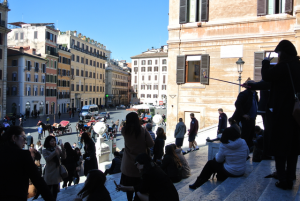
Spanish Steps Rome
The Spanish Steps are one of Rome’s most famous sites and among the world’s best-know steps. The 135-step stairway connects the Piazza di Spagna with the Trinità dei Monti church located above.
The steps take their name from the Spanish embassy that has been located on the square for centuries. The first plans for steps were drawn up by Pope Gregory XIII in the late 16th century but no action was taken for over a century. The steps were completed in 1717. The fountain in the piazza just in from of the steps was created by Petro and Gian Lorenzo Bernini (father and son). The sinking boat depicts an old tale of a sinking ship.
Like the Trevi Fountain the Spanish Steps were immortalized in the 1953 film, Roman Holiday, starring Audrey Hepburn and Gregory Peck.
Piazza del Popolo
The Piazza del Popolo – The People’s Square – takes its name from the church of Santa Maria del Popolo. It is located at the northern confluence of the Via di Ripetta, Via del Corso, and Via del Babuino, and the city’s ancient northern gate in the Aurelian Walls.
The piazza was designed and constructed between 1811 and 1822 and clearly takes inspiration from Bernini’s plan for St. Peter’s Square. The centerpiece of the square features a fountain and great Egyptian obelisk known as Flamino built by Psammetichus II in Egypt near 590 BC. This obelisk was taken from Egypt in 10 BC by the Emperor Augustus and was originally placed in the center spina of the Circus Maximus.
Last but certainly not least is the neighborhood of Trastevere. Trastevere is part of Rome but it feels like a quaint village. If you are in Campo de’ Fiori you are just minutes away from Trastevere. Take a stroll across the beautiful Ponte Sisto and spend some time exploring the tiny streets of Trastevere stoping for drinks and perhaps lunch or dinner. No trip to Rome is complete without experiencing Trastevere.
When in Rome… don’t miss the opportunity to visit several of Rome’s many great wine bars. See our story on Wine Bars in Rome.
By Request – My Tips for Visiting Rome
- Bring comfortable walking shoes. Rome is one of the best walking cities in the world and it does have hills, steps, tarmac, old cobblestone, and stones. If you bring a new, untested, not-broken-in pair of shoes your feet will rebel.
- Rome is filled with great places to eat. If a restaurant has posted someone out front to shove amen in your face and try to direct you into their place just walk away. Don’t be annoyed as they are providing a service letting you know that you never, ever want to eat there.
- Hire a car for your airport transfer. There are many car service companies in Rome that will collect you at the airport and take you straight to your hotel. The going rate is 50 euros and it’s worth every penny. There is an express train at FCO airport to Termini Station in Rome. This express train should be considered only if you are traveling alone, you are traveling with few and light bags, and you are staying a short walk away from Termini station. Short of meeting all of these requirements you will inevitably pay equal to the car service and you will put yourself through unnecessary headaches.
- Be an early riser. Rome is the eternal city and it draws visitors from every corner of the globe. Rome is busy even in the off season (the only time to go) so get up early before the crowds get moving so you can see the city’s beautiful sites in relative solitude. Plus, the morning light on the city is amazing.
- Walk across the Ponte Sisto at night.
- Drink wine. Drink a lot of wine in Rome.
